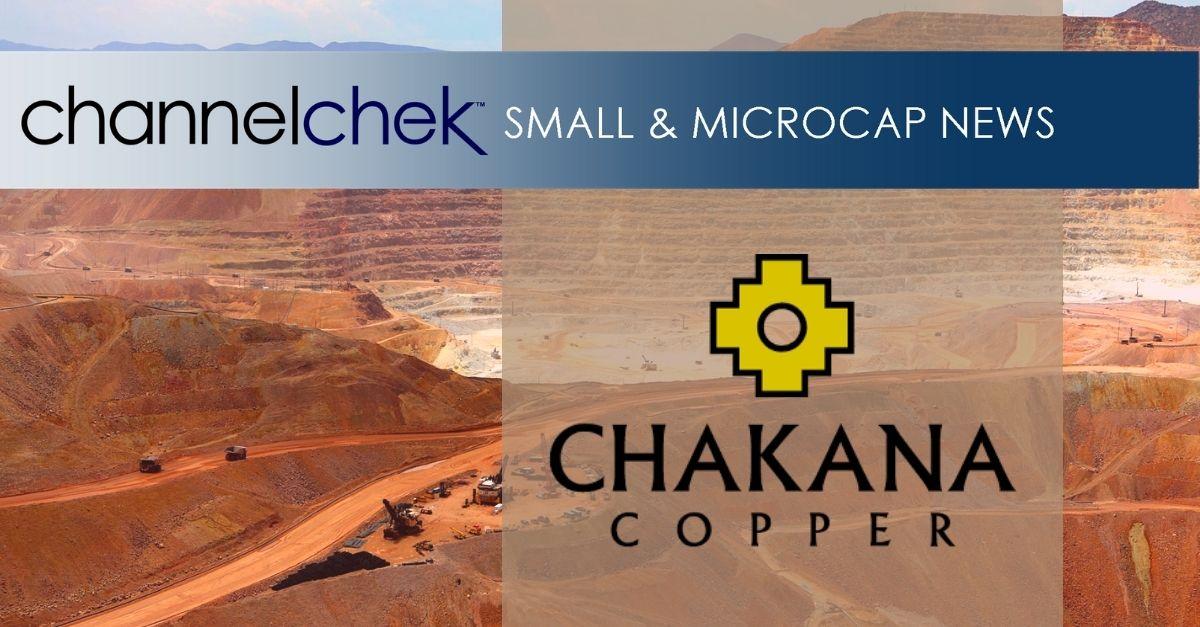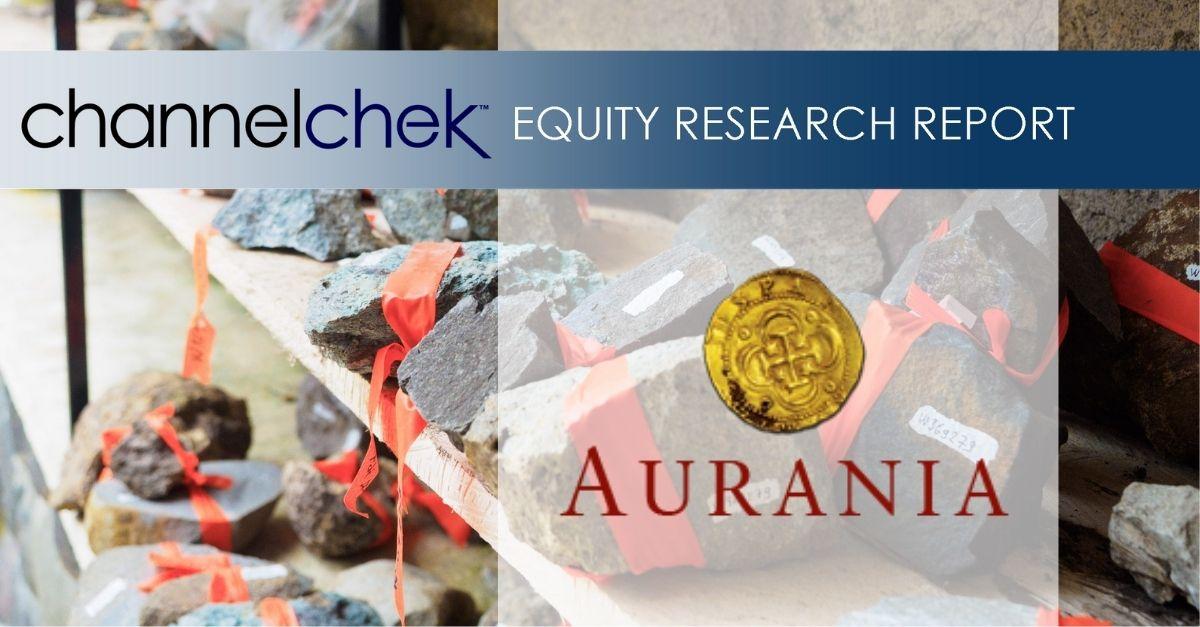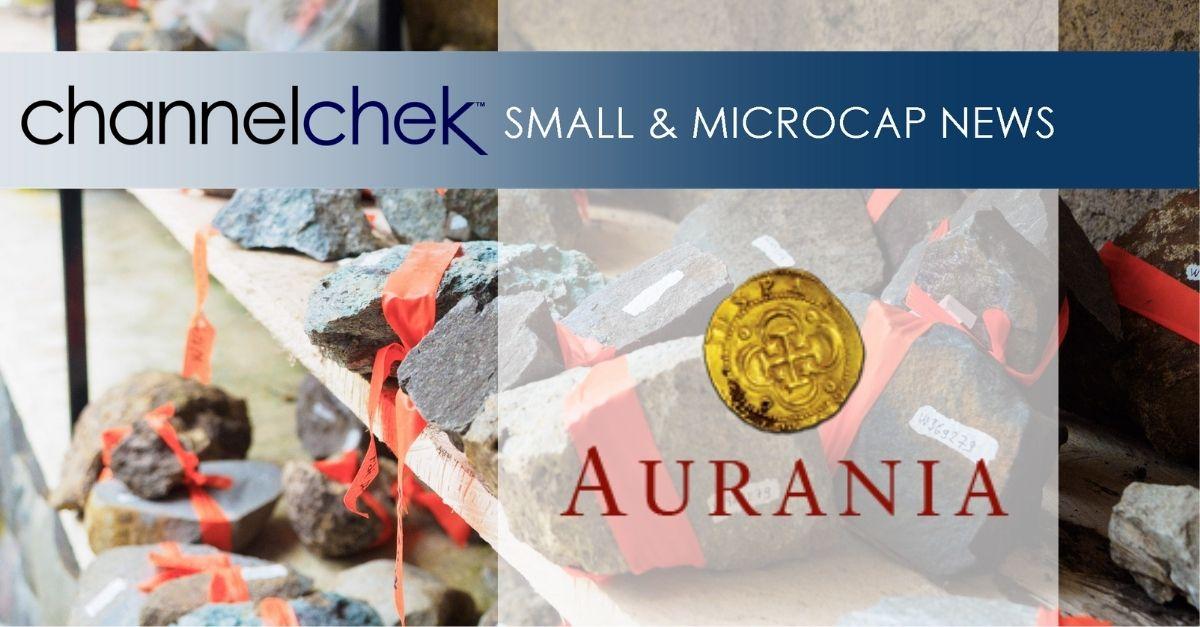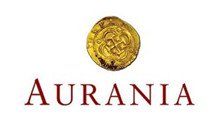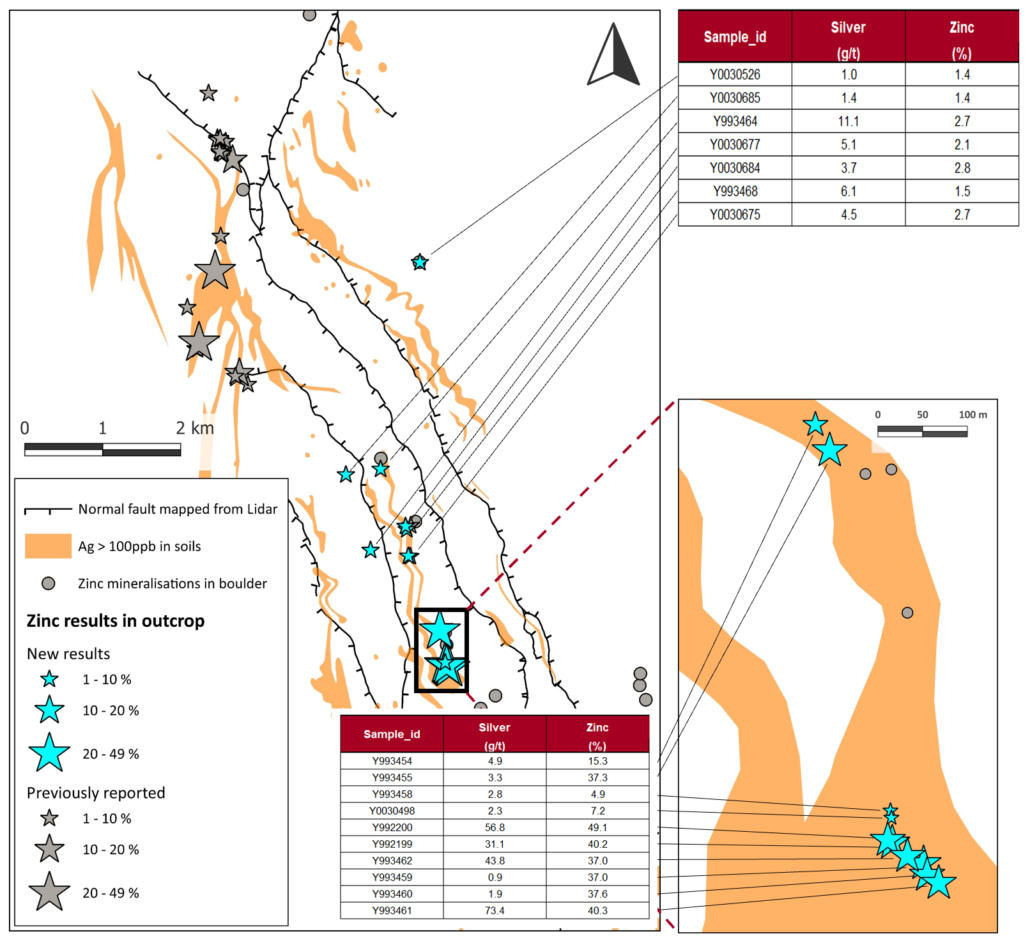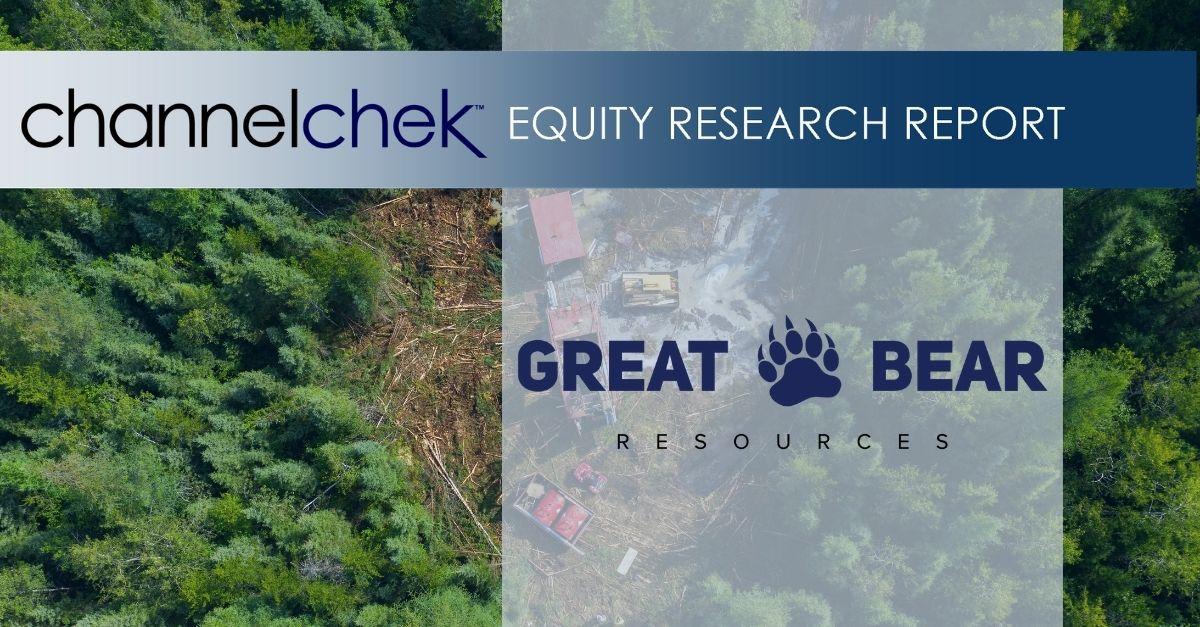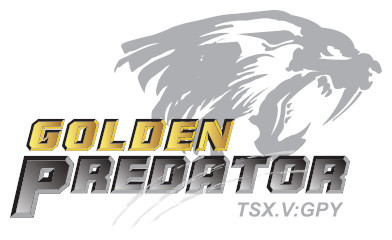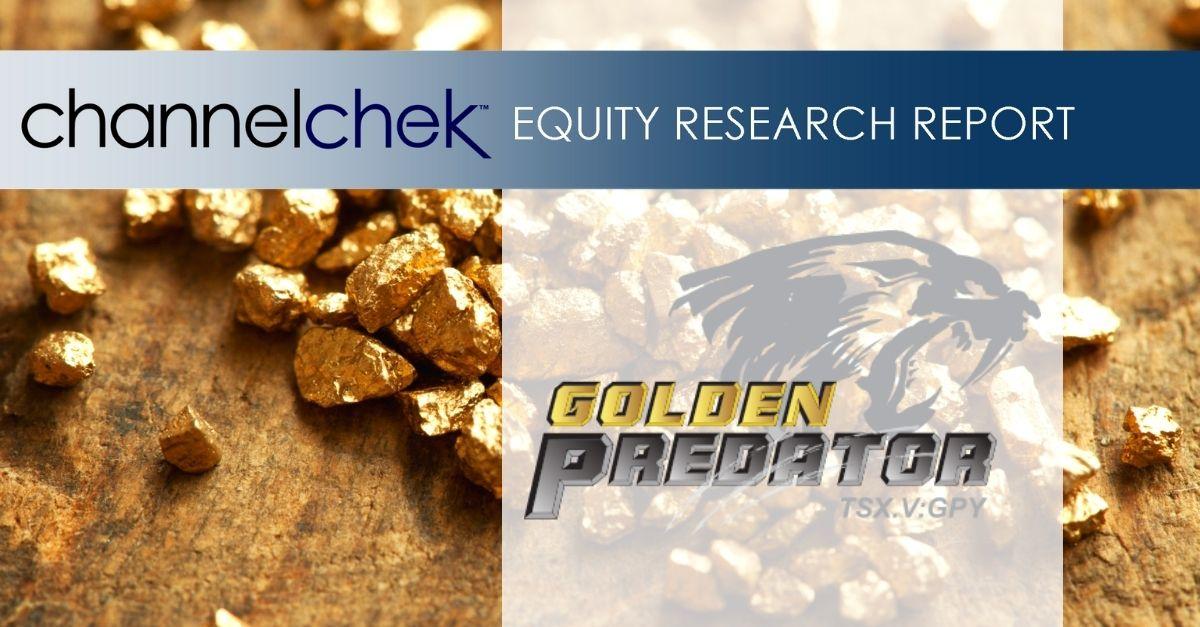
Chakana Advances Resource Definition Drilling With Multiple High-Grade Intercepts
Soledad Project Highlights Include:
- Huancarama East – four holes with high-grade intercepts, including 134.3m of 0.92 g/t Au, 0.86% Cu, and 80.7 g/t Ag (2.15% Cu-eq) from 119.7m depth;
- Paloma East – five holes with strong grades, including 126.1m of 0.91 g/t Au, 0.20% Cu, and 11.6 g/t Ag (0.89% Cu-eq) starting at surface;
- Paloma West – two holes with high grades, including 101.0m of 0.53 g/t Au, 1.01% Cu, and 41.5 g/t Ag (1.71% Cu-eq) starting at surface.
Vancouver, B.C., May 25, 2021 – Chakana Copper Corp. (TSX-V: PERU; OTCQB: CHKKF; FRA: 1ZX) (the “Company” or “Chakana”), is pleased to provide results from eleven in-fill holes totaling 2,873.7m from the Huancarama, Paloma East, and Paloma West tourmaline breccia pipe discoveries at its Soledad project, Ancash, Peru (Table 1). Drilling continues as part of a fully-funded 26,000m exploration and resource drilling program planned for 2021 (Fig. 1).
David Kelley, President and CEO commented, “The resource definition drilling portion of our current program is going exceptionally well with excellent results from the three discoveries at Soledad since the resumption of drilling in 2020. Huancarama and Paloma West continue to demonstrate their high-grade nature, and strong grades were also encountered at Paloma East. Mineralization in all three breccia pipes starts at surface and is open at depth. These results are another positive step toward our resource estimate due out later this year that will include multiple breccia pipes. To date, we have only tested 15 out of the 110 total targets on the property.”
Resource Definition Drilling
Table 1. Mineralized intervals from resource definition drilling at Huancarama, Paloma East, and Paloma West.
| DDH # | FROM – TO (M) | CORE LENGTH (M) | AU G/T |
AG G/T |
CU % | CU-EQ %* |
AU-EQ G/T* | |
|---|---|---|---|---|---|---|---|---|
| Huancarama East | ||||||||
| SDH21-189 | 119.70 | 254.00 | 134.30 | 0.92 | 80.7 | 0.86 | 2.15 | 3.29 |
| and | 271.00 | 310.00 | 39.00 | 0.61 | 52.4 | 0.88 | 1.73 | 2.64 |
| SDH21-193 | 29.20 | 38.80 | 9.60 | 1.35 | 78.8 | 2.38 | ||
| and | 110.00 | 273.00 | 163.00 | 0.26 | 20.1 | 0.43 | 0.77 | 1.18 |
| SDH21-194 | 21.90 | 25.70 | 3.80 | 0.17 | 77.3 | 0.23 | 1.00 | 1.53 |
| and | 120.00 | 244.00 | 124.00 | 0.33 | 29.5 | 0.63 | 1.10 | 1.68 |
| and | 301.00 | 308.10 | 7.10 | 1.81 | 36.7 | 0.81 | 2.31 | 3.53 |
| SDH21-198 | 144.00 | 210.00 | 66.00 | 0.99 | 82.6 | 1.01 | 2.36 | 3.62 |
| including | 166.00 | 197.00 | 31.00 | 1.46 | 149.9 | 1.77 | 4.01 | 6.13 |
| Paloma East | ||||||||
| SDH21-190 | 0.00 | 126.10 | 126.10 | 0.91 | 11.6 | 0.20 | 0.89 | 1.37 |
| including | 21.00 | 38.00 | 17.00 | 5.09 | 15.7 | 5.30 | ||
| SDH21-191 | 0.00 | 99.40 | 99.40 | 0.62 | 12.5 | 0.31 | 0.82 | 1.26 |
| and | 144.00 | 198.70 | 54.70 | 0.16 | 13.9 | 0.22 | 0.44 | 0.68 |
| SDH21-192 | 64.90 | 124.00 | 59.10 | 0.27 | 7.5 | 0.42 | 0.66 | 1.01 |
| and | 198.00 | 224.00 | 26.00 | 0.21 | 33.3 | 0.65 | ||
| SDH21-195 | 53.00 | 121.00 | 68.00 | 0.28 | 7.3 | 0.31 | 0.56 | 0.85 |
| SDH21-196 | 67.00 | 121.00 | 54.00 | 0.20 | 9.0 | 0.74 | 0.95 | 1.45 |
| Paloma West | ||||||||
| SDH21-197 | 27.00 | 84.80 | 57.80 | 0.53 | 69.4 | 1.17 | 2.11 | 3.23 |
| including | 28.20 | 49.00 | 20.80 | 1.06 | 183.8 | 2.32 | 4.58 | 7.01 |
| SDH21-199 | 0.00 | 101.00 | 101.00 | 0.53 | 41.5 | 1.01 | 1.71 | 2.62 |
| including | 31.25 | 50.00 | 18.75 | 1.07 | 141.8 | 3.29 | 5.20 | 7.96 |
* Cu_eq and Au_eq values were calculated using copper, gold, and silver. Metal prices utilized for the calculations are Cu – US$2.90/lb, Au – US$1,300/oz, and Ag – US$17/oz. No adjustments were made for recovery as the project is an early-stage exploration project and metallurgical data to allow for estimation of recoveries are not yet available. The formulas utilized to calculate equivalent values are Cu-eq (%) = Cu% + (Au g/t * 0.6556) + (Ag g/t * 0.00857) and Au-eq (g/t) = Au g/t + (Cu% * 1.5296) + (Ag g/t * 0.01307).
Huancarama East
Four holes were drilled through the Huancarama East breccia pipe from step-out platforms (Figs. 2 and 3). One hole was drilled to the northeast, and three holes were drilled from east to west. All four holes intersected mineralized breccia, consistent with previous exploration holes (see news releases dated January 12, January 25, February 9, March 3, and April 28, 2021) with depths ranging between approximately 80m to 300m below surface. The breccia pipe has approximate lateral dimensions of 100m by 60m and is open at depth. Additional infill holes have been drilled, with more planned once assay results have been received. Examples of mineralized drill core from these holes are shown in Figure 4.
Paloma East and Paloma West
The Paloma breccia pipes are located 300m north of Huancarama and are partially exposed at surface (Fig. 3). Five holes were drilled at Paloma East. Three holes were collared on the west side of the breccia pipe and drilled to the east, northeast, and southeast, and two holes were drilled from the north side of the exposed breccia pipe and oriented southwest and south. Mineralization was encountered in all five drill holes over a vertical range from surface to approximately 200m depth. Two resource definition holes were drilled at Paloma West from a platform on the northeast side of the exposed breccia pipe and drilled to the southwest. High-grade mineralization was intersected in both drill holes with depths ranging between approximately 20m to 80m below surface. Breccia in both pipes is open at depth and results presented here are consistent with previously reported results (see news releases dated September 17, October 26, November 18, December 3, and December 16, 2020; and April 28, 2021). Additional infill holes have been drilled at Paloma West with results pending. Examples of mineralized drill core from these holes are shown in Figure 4.
2021 Resource and Exploration Drill Program
Results reported here are part of the fully funded 2021 drill program of 26,000m. Combined with the drilling in the second half of 2020, approximately 32,000m is anticipated through 2021. Of this, 13,946.2m have been reported in 67 drill holes for the Paloma and Huancarama areas. Within the 26,000m of drilling planned in 2021, the Company will complete approximately 16,000m of resource definition in-fill drilling. The results of this drill program are important to increase confidence in the resource estimate, anticipated later in 2021.
Additionally, 10,000m of exploration drilling is planned for 2021. This will focus on new targets located in the northern portion of the project that have not been drilled previously but are strategic to any eventual development at Soledad. Exploration targets have been ranked based on their technical merit, access, and logistics.
About Chakana Copper
Chakana Copper Corp is a Canadian-based minerals exploration company that is currently advancing the Soledad Project located in the Ancash region of Peru, a highly favorable mining jurisdiction with supportive communities. The Soledad Project consists of high-grade gold-copper-silver mineralization hosted in tourmaline breccia pipes. A total of 47,736 metres of exploration and resource definition drilling has been completed to date, testing 15 of 110 total exploration targets, confirming that Soledad is a large, well-endowed mineral system with strong exploration upside. Chakana’s investors are uniquely positioned as the Soledad Project provides exposure to several metals including copper, gold, and silver. For more information on the Soledad project, please visit the website at www.chakanacopper.com.
Sampling and Analytical Procedures
Chakana follows rigorous sampling and analytical protocols that meet or exceed industry standards. Core samples are stored in a secured area until transport in batches to the ALS facility in Callao, Lima, Peru. Sample batches include certified reference materials, blank, and duplicate samples that are then processed under the control of ALS. All samples are analyzed using the ME-MS41 (ICP technique that provides a comprehensive multi-element overview of the rock geochemistry), while gold is analyzed by AA24 and GRA22 when values exceed 10 g/t by AA24. Over limit silver, copper, lead and zinc are analyzed using the OG-46 procedure. Soil samples are analyzed by 4-acid (ME-MS61) and for gold by Fire Assay on a 30g sample (Au-ICP21).
Results of previous drilling and additional information concerning the Project, including a technical report prepared in accordance with National Instrument 43-101, are made available on Chakana’s SEDAR profile at www.sedar.com.
Qualified Person
David Kelley, an officer and a director of Chakana, and a Qualified Person as defined by NI 43-101, reviewed and approved the technical information in this news release.
ON BEHALF OF THE BOARD
(signed) “David Kelley”
David Kelley
President and CEO
For further information contact:
Joanne Jobin, Investor Relations Officer
Phone: 647 964 0292
Email: jjobin@chakanacopper.com
Neither TSX Venture Exchange nor its Regulation Services Provider (as that term is defined in the policies of the Exchange) accepts responsibility for the adequacy or accuracy of this release.
Forward-looking Statement Advisory: This release may contain forward-looking statements. Forward-looking statements involve known and unknown risks, uncertainties, and other factors which may cause the actual results, performance, or achievements of Chakana to be materially different from any future results, performance, or achievements expressed or implied by the forward-looking statements. Forward looking statements or information relates to, among other things, the interpretation of the nature of the mineralization at the Soledad copper-gold-silver project (the “Project”), the potential to expand the mineralization, and to develop and grow a resource within the Project, the planning for further exploration work, the ability to de-risk the potential exploration targets, and our belief in the potential for mineralization within unexplored parts of the Project. These forward-looking statements are based on management’s current expectations and beliefs but given the uncertainties, assumptions and risks, readers are cautioned not to place undue reliance on such forward- looking statements or information. The Company disclaims any obligation to update, or to publicly announce, any such statements, events or developments except as required by law.
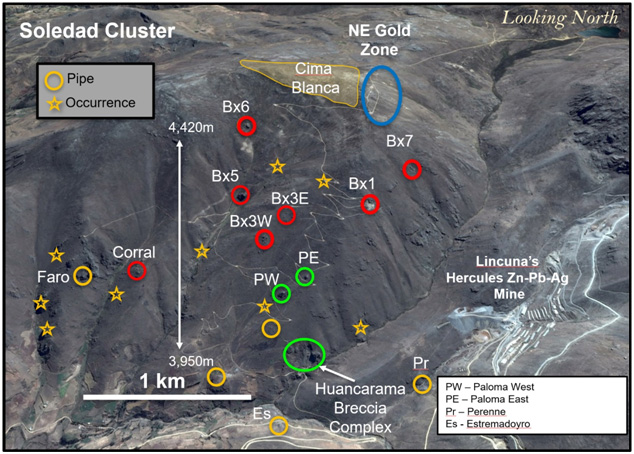
Figure 1 – View looking north showing breccia pipes and occurrences within the northern Soledad cluster. Pipes that have been drilled in previous campaigns are shown in red. Outcropping breccia pipes shown in green are the focus of the current drill campaign. Other pipes and occurrences remain to be tested by drilling. Additional breccia pipes occur on the south half of the property and are not shown here.
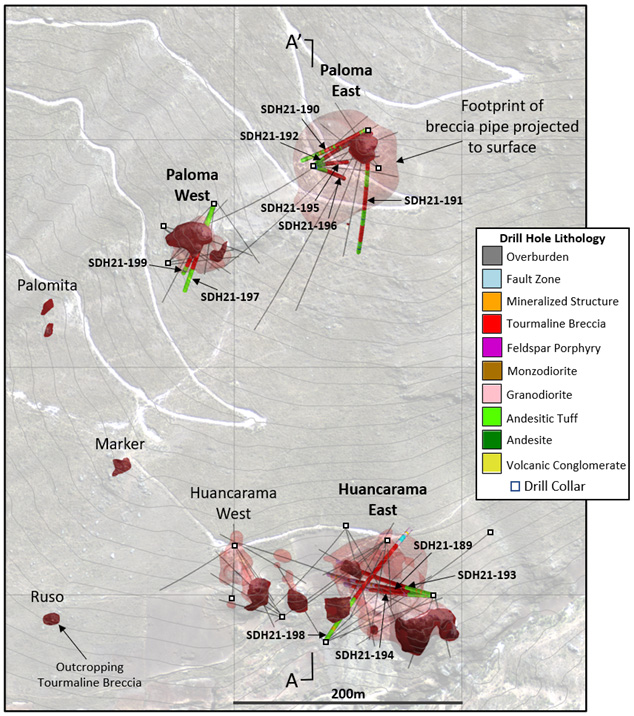
Figure 2 – Map of Paloma and the Huancarama Breccia Complex showing drill holes reported in this release, outcropping tourmaline breccias (dark red shapes), and modeled breccia pipes (light red shapes) based on all drill holes (previous drilling shown by dark gray traces). Light gray contours are 10m interval. Untested outcropping targets are also shown. Location of section line (A-A’) for Figure 3 indicated.
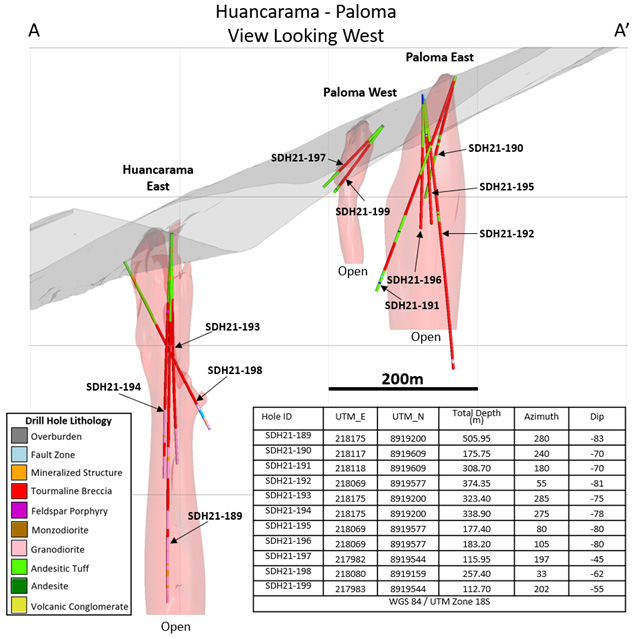
Figure 3 – Isometric view looking west highlighting the drill holes at Huancarama and Paloma reported in this release. Light red 3D shapes show preliminary shape of breccias based on all drill holes (see Figure 2).
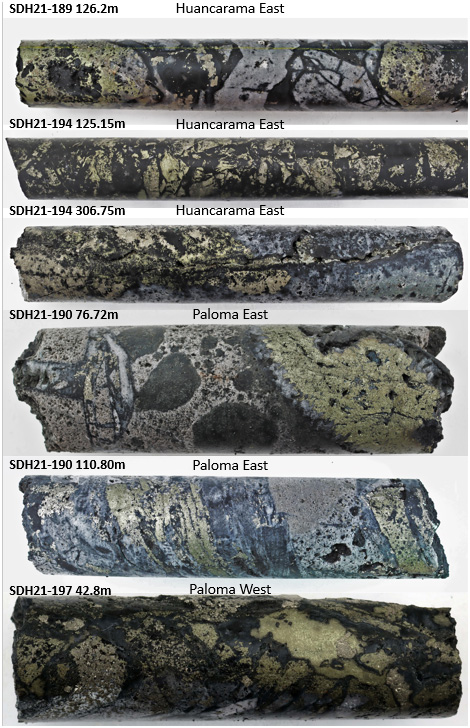 Figure 4 – Select core photos from Huancarama, Paloma East, and Paloma West reported in this release: SDH21-189 (126.2m) mosaic and jigsaw tourmaline breccia with sulfide cement; SDH21-194 (125.15m) mosaic breccia with selective clast replacement by chalcopyrite and pyrite; SDH21-194 306.75m tourmaline breccia with late chalcopyrite replacement along vein; SDH21-190 (76.72m) tourmaline breccia with chalcopyrite filling open space; SDG21-190 (110.80) shingle breccia with selective chalcopyrite replacement of shingle clasts; SDH21-197 (42.8m) mosaic tourmaline breccia with selective clast replacement and open space filling by chalcopyrite and pyrite. Core diameter is 6.35cm (HQ) in all instances.
Figure 4 – Select core photos from Huancarama, Paloma East, and Paloma West reported in this release: SDH21-189 (126.2m) mosaic and jigsaw tourmaline breccia with sulfide cement; SDH21-194 (125.15m) mosaic breccia with selective clast replacement by chalcopyrite and pyrite; SDH21-194 306.75m tourmaline breccia with late chalcopyrite replacement along vein; SDH21-190 (76.72m) tourmaline breccia with chalcopyrite filling open space; SDG21-190 (110.80) shingle breccia with selective chalcopyrite replacement of shingle clasts; SDH21-197 (42.8m) mosaic tourmaline breccia with selective clast replacement and open space filling by chalcopyrite and pyrite. Core diameter is 6.35cm (HQ) in all instances.
